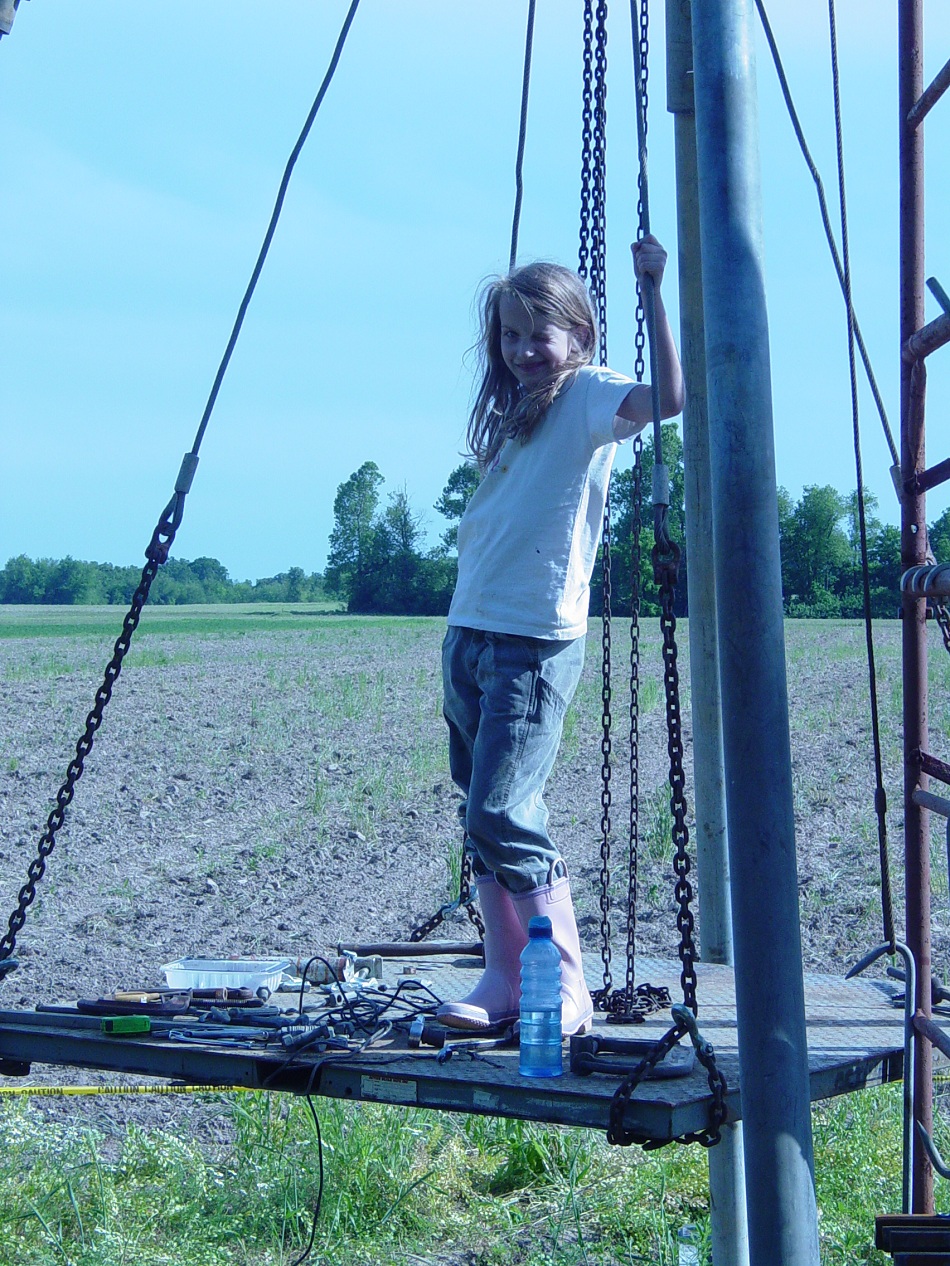2009
Return to Timeline.
Return to Table of Contents.

In
2009 Bob Cassilly put a Ferris Wheel on the roof of City Museum.
He asked Dean,
as Science Director (staff Mad Scientist), to figure out a way to harness wind energy
up there to run the Ferris Wheel.
A propeller type would not work in the city.
At 600 rpm, if a blade came loose, it would pin a UPS truck to the pavement.
Therefore,
it was necessary to use a slower moving device.
Pictured here is the base of the
machine. It would be built on the ground, tested, disassembled and reassembled on
the roof of City Museum.
The site super is standing there goofing off ( two hands
in the pockets means 'goofing off').

Finally
got their attention. Winking doesn't qualify as working either.

Here
is the power transmission shaft and the first cross-members.

Here
is the finished device.
Before it could be moved, Bob Cassilly was killed in a
bulldozer accident.
His widow sold her interest in City Museum to a billionaire
who busily began erasing everyone else's participation and contributions.
When
Dean approached them about the commission by Bob to build this machine they basically
said "Who are you?"
"Eat the rich- the other white meat."
The
machine performed flawlessly and generated about 25 hp at a constant rotation of
27 rpm- perfect to harness to a Ferris Wheel.
It survived two bouts with 80 mph
linear winds at the farm. One day, Dean noticed a bolt backing out.
Putting it
off til another day (namely the next 80 mph wind burst) resulted in a bent arm which
now needs to be repaired.

After
the regular occurence of 80 mph winds, Dean's mind wandered to the hurricanes he'd
weathered in Jamaica.
Buildings down there have the roofs attached to the walls
by strips of metal called "hurricane straps".
Inspecting the barn yielded
a "gravity fit". If the roof lifted off, it would be transported to the
adjacent field.
A similar occurence happened in 1986, when the entire north wall
of the combine shed peeled off and was deposited next to the lake.
Dean disassembled
the entire wall and carried it back to the shed and reassembled it- with straps.
Visible
here is the beginning of sheathing the barn in the galvanized corrugated salvaged
from the granary.
Six inch anchors went all the way through the metal and one-by-twelves
and into the oak logs.
This would give the sheet metal the "membrane effect"
and greatly enhance the integrity of the wall.
Sort of like steel plywood. And
stopped all the breeze blowing. Think of all the years those cows froze in January.
The
red spray-paint lines are the approximate interior position of the logs located for
attachment. Drilling into air doesn't hold well.

Distance
photo showing the truckloads of corrugated.
This is the oldest barn in Illinois
and the largest log structure in Illinois.
In the 1980's, Dean contacted the National
Register for Historic Places. The farm was an ideal candidate because it was an original
settlement.
It is an intact assemblage of contemporaneous log buildings.
Through
Dean's efforts, everything has been stabilized and protected from the elements.
He
was told it was not eligible because siding had been placed on the buildings and
he was to remove it.
Morons. The siding was installed in the 1890's and it had
square nails as well. It is technically antique also.

Visible
here is the outward bowing of the walls from the weight of the roof from one hundred
and eighty plus years.
It was about to push off the top logs and collapse. About
another inch to go.
It was sufficiently necessary to stop work on the other projects
and give this immediate attention.

Dean
went along the interior roof-line and every six feet drilled the logs and put an
"eye" bolt through.
He did this on both sides and between the two "eye"
bolts stretched a 3/8ths inch diameter aircraft cable.
Attached to each one of
these was a ton and a half lever hoist. So, across the length of the barn are a dozen
lever hoists and cable assemblies.
Then they were drawn tight. Then every couple
of months (or when he remembers it), Dean crawls up in the loft and tightens every
hoist one click.
Over a period of years, the barn will regain its original shape
without cracking boards or displacing logs. Patience is a virtue.
Here is a pair
of the hoists. See how the logs have slipped about four inches away from resting
on the other logs (directly below the far hoist).
On the top log attached to alternating
roof joists can be seen the hurricane straps.

In
November, Dean lost his leading light.
Every time he visits, he leaves a black
walnut.
Return to Timeline.
Go to 2010.








